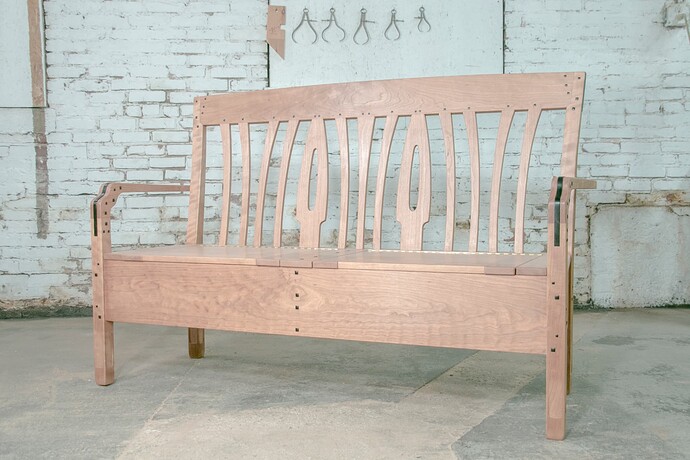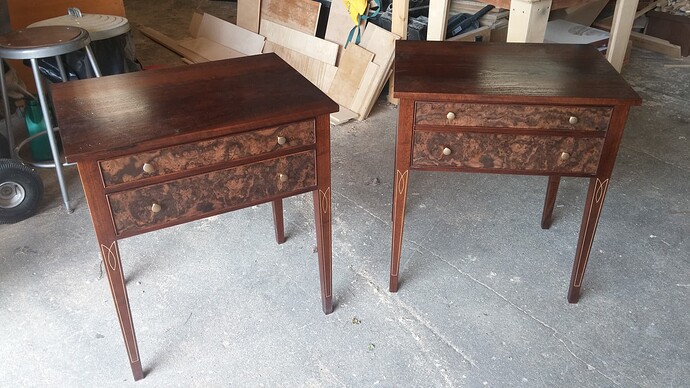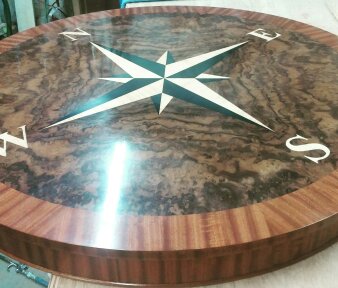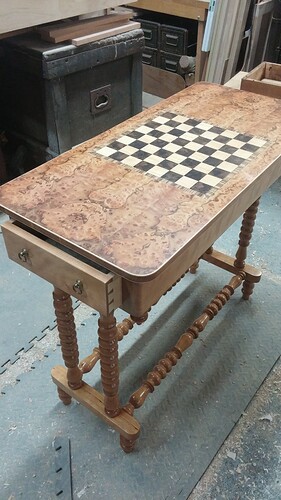Hello everyone. This is my first post to this forum. I ordered a new Shapeoko Pro xxl and should receive it on Friday. Pretty excited about this. I have very limited CNC experience but have been a professional furniture, cabinetmaker, and woodworking instructor for the past 10 years. I hold a degree in Furniture and Cabinetmaking from North Bennet Street School where I have continued to teach traditional woodworking.
My shop has a good collection of old iron machinery since I am coming from a traditional furnituremaking background but I have been exposed to cnc in other peoples shops. Seeing how efficient these machine can be I have been outsourcing to my buddy to bring my pricing down. Mainly v carved signs and labels for furniture.
Becoming sick of traveling to have parts engraved or cut out on my buddies Industrial CNC (Yes that is the brand and it is definitely a relabeled imported cnc) so I decided to take the plunge and buy my own small cnc for the shop.
I have been trying to decide what to get for more than a year and even priced out a 4x8 ShopSabre and CamMaster but in the end decided that I wanted to start on a smaller benchtop machine that I could learn on before making the large financial and space commitment that those larger machines demand. Who knows it may not work with my business to have such a large machine. Time will tell.
It looks like this community is really pleased with the performance/value of these machines so I am excited to see what I can do with it.
Welcome!
Have you checked out the assembly instructions?
Let us know if you have and difficulties or problems either here (if you want an unofficial discussion and for the community to weigh in), or at support@carbide3d.com (for official assistance).
Hi Ryan,
Welcome to the community!
I’ll leave this here for you too then 
A Shapeoko Pro seems like the ideal machine for your situation, I’m looking forward to seeing what you do with it!
Hi Ryan:
I’d like to ask some questions if you don’t mind.
Can you tell us what falls into traditional woodworking as far as college / classes go? And what do you call what falls outside? Modern woodworking? Industrial woodworking? Are those classes taught as well? Is there further differentiation between power tools and non-power tools?
I understand joinery is a big part; I would guess few would say pocket screws is traditional woodworking. How about say box joint with plywood where you have relatively modern materials where you don’t have to respect the grain / expansion / contraction as much. Thanks.
I am not sure that I answered your question. We use a combination of modern machinery and hand tools to construct high end furniture and cabinets. The school concentrates on traditional joinery and techniques that have been proven over time to build furniture. Lots of mortise and tenon, dovetails etc. There is less of an emphasis on production or batch work and more attention to proper construction and best quality. Plywood is rarely used at the school although we make our own lumber core for veneer work. The school teaches a lot of hand tool classes as well as some core machinery classes. No cnc but proper use and setup of planers, jointers, tablesaws, bandsaws, lathes, etc. The schools students and alumni produce some amazing work.
I feel like you need to master both the machinery and hand tool work in order to produce unique high quality custom furniture. In my own work I use a combination of modern material, hand and power tool techniques to produce my pieces. This can range from cutting boards to full kitchens to period furniture. I can see the adaptation of cnc use in the shop will help with cabinetwork, engraving, patternwork, joinery and other odds and ends.
I watched an assembly video which was great. I liked the suggestion to not take everything out of their respective boxes before you need them so as to not clutter the workspace! I have lost all sorts of bolts and fasteners by doing exactly that!
To expand on @RyanM 's answer, usually traditional woodworking is that done w/ hand-tools and techniques which have a long history of use.
A great resource on this is:
- Choosing and Using Hand Tools by Andy Rae: https://www.goodreads.com/book/show/2340743.Choosing_Using_Hand_Tools
and of course there is always Roy Underhill:
Usually power tools (beyond resawing and prepping stock) would not be considered traditional, even old joints such as the Knapp (pin and cove/scallop):
That said, I wouldn’t consider a machine cut dovetail traditional either:
That said, we’ve worked out how to do some very old joinery techniques:
Thanks for your post, Ryan. I see there is already some difference between your class and what Will considers traditional woodworking.
We are all coming from different directions and some of us are going to different places. Judging by YouTube, there is a population that makes everything they need out of 2x4’s and a circular saw (speed square optional). Then on the other side, Ryan and his students are using a combination of modern and traditional tools to make exquisite pieces. Will zones out the power tool users and leaves an even more exclusive group of hand tool users.
I myself am interested in the form and history and can appreciate the technique, but am not interested in copying the way. I tried cutting a mortise via chisel and will say never again. Something as necessary as sharpening a chisel or plane blade is not so basic. Even setting up and using the router to do this is a pretty tense experience for me. Now I’d rather just draw it out and let the CNC do it. I’d love to abstract the form of period furniture, but would not have the commitment to be able to do it by hand.
Probably folks would exempt a lathe — not everyone has room for a bodge.
Welcome to the brood Ryan!
Welcome to the community Ryan!
Yes turning is another trade but I am a professional turner as well and have both a manual lathe and an Italian SCMI copy lathe in the shop. At one time I had four lathes in the shop. I am looking to upgrade to a hydraulic or cnc lathe in the future.
Welcome. That is an impressive resume of furniture you have there.
Hey Ryan, I’m the exact opposite. I’ve spent the last 40 years working with industrial CNC routers and know little about what you call traditional woodworking. I purchased my first CNC in 1980, the woodworking industry didn’t have much to offer at that time, and the CNC was built to cut and drill circuit boards. Now that I’m retired, I thought it would be fun to have a CNC that I could play around with. I purchased the Shapoko 3 XXL, and I’ve been pleased with it. The thought of playing around vanished quickly, and I started producing products I could sell. I’ve been working the hell out of this machine for a couple of years, and it’s still working great. Because of my history, I’m spoiled, and I think I will buy the new Shapoko HDM that will be out soon. I’m still shocked at how little these machines cost compared to industrial CNCs and how well they work.
For those talking about cutting dovetails or finger joints, remember your cutting with a round cutting tool. Thus it’s impossible to create a sharp inside corner. You can adjust by cutting round outside corners that will match the inside corners. If you do this, you will quickly learn about cutter compensation because as soon as you sharpen a cutting tool, it no longer has the same diameter, and your parts will no longer match. I think anything can be accomplished, but it may take a little more work than expected.
For doing dovetails see:
There are a couple of options on finger joints — traditional (cut like the dovetails using a fixture which holds one board a 90 degrees to the other):
or relieving the fingers in some fashion:
Nice!
I know there are two worlds of woodworking and it is great that you can mix and match the two depending on what you want to accomplish.
Dovetails are always a pain to cut. I have a Leigh jig for small production but it can be really finicky. Honestly when I am building a nice piece for a client I end up cutting the dovetails by hand. They look better and I am really fast at them.
That being said when I build a kitchen I sub out the dovetail drawers to specialty company that has all the machinery to mass produce them.
It would be cool to try and make some half blinds on the Shapeoko just for the experience so I may do it in the future.
I am still getting used to basic cnc operations at the moment. Having some fun making jigs and signs right now. But I am having an issue with the z axis just plunging at random. Have to get that sorted out.



